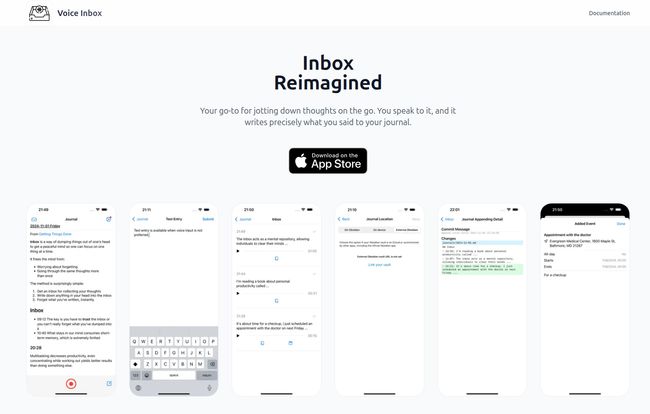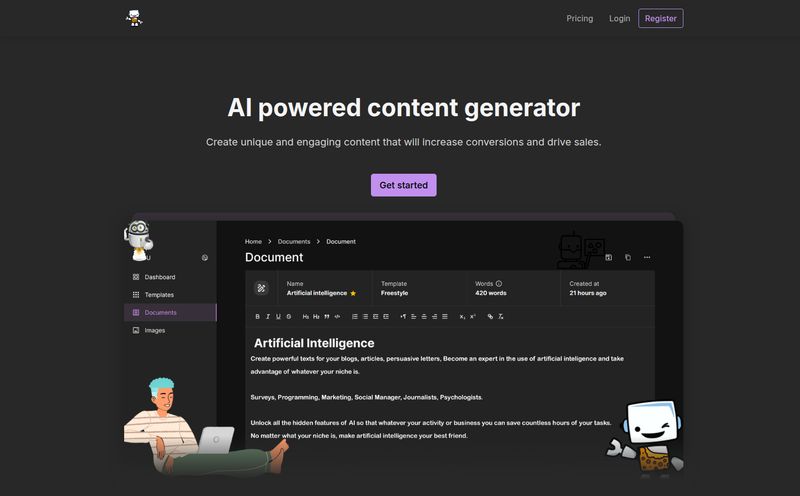How many brilliant ideas have you lost to the ether? You know the ones. The perfect blog post angle that hits you in the shower. The solution to a complex coding problem that appears while you're walking the dog. The killer comeback to an argument you had three hours ago. By the time you find a pen or unlock your phone and navigate to your notes app, the magic is gone. The thought is a ghost, a faint echo of its former genius.
It’s a tale as old as time, or at least as old as our distractible, always-on brains. For years, I’ve been on a quest for the perfect, frictionless capture method. I've tried everything from pocket notebooks (which get left behind) to clunky voice memo apps that leave me with an hour of audio to transcribe later. Ugh. It often feels like more work than it's worth.
Then, I stumbled upon a tool that seemed to be speaking my language. Literally. It’s called Voice Inbox, and its promise is simple yet profound: “You speak to it, and it writes precisely what you said to your journal.” For an Obsidian user like me, this felt like finding a missing piece of my personal knowledge management (PKM) puzzle.
So, What Exactly is Voice Inbox?
Let's clear one thing up right away: Voice Inbox isn't trying to be another bloated, all-in-one note-taking app. Thank goodness. We have enough of those. Instead, it positions itself as an “inbox” for your thoughts, a dedicated capture tool designed to do one thing exceptionally well: get your spoken words into your notes with as little friction as possible.
Think of it as a digital valet for your brain. You have a fleeting thought, you open the app, you speak, and poof—it’s transcribed and waiting for you in your designated journal. The core idea, as the developers put it, is to minimize cognitive load. You don’t have to think about formatting, or finding the right folder, or even typing. You just speak. This is what they mean by “Inbox Reimagined.” It's not a place for tasks to pile up, but a seamless channel for ideas to flow through.

Visit Voice Inbox
The Core Features That Actually Matter
An app can have a great philosophy, but it lives or dies by its execution. I've been kicking the tires on Voice Inbox, and a few features really stand out—for better or for worse.
That "Human-Level" Transcription: Does It Hold Up?
This is the big one. The app’s landing page boasts of human-level transcription accuracy, powered by “the best AI model.” That’s a bold claim. We’ve all been burned by Siri and Google Assistant’s… creative interpretations of our speech. A transcription service that’s only 90% accurate is almost useless, because the time you spend correcting the errors negates the time you saved by not typing.
In my experience, Voice Inbox gets impressively close to its claim. It handles technical jargon and mumbled phrases with surprising grace. I dictated a few notes about CPC optimization and SERP volatility, and it didn't stumble once. This high quality is apparently due to cloud-based processing, which is a trade-off we’ll talk about in a bit. But for pure performance? It’s solid. It turns a rambling voice note into clean, usable text, which is the whole point.
The Obsidian Integration: A Match Made in Markdown Heaven
Here’s the heart of the workflow for me, and what makes Voice Inbox so special. It integrates directly with Obsidian. If you’re in the PKM world, you know Obsidian is a powerhouse for building a “second brain.” It’s local-first, based on plain text Markdown files, and infinitely customizable.
Voice Inbox hooks right into that ecosystem. You can configure it to save your transcribed notes directly to your Obsidian vault, whether you're using iCloud or a more complex Git-based setup for syncing. This is huge. It means my shower thoughts don’t just end up in a random app; they land directly in my daily note or a designated “inbox.md” file, ready to be processed and linked to other ideas. It’s the kind of seamless integration that workflow nerds dream about.
Of course, this is also its biggest limitation right now. It's a one-trick pony in the integration department. If you're a Notion, Roam, or Evernote user, you’re currently on the outside looking in. The developer does say they're open to supporting other platforms based on user feedback, which is encouraging.
Smart Features: Calendar Event Recognition
This was a delightful surprise. While dictating a thought, you can say something like, “Remind me to schedule a meeting with the design team for Thursday at 2pm.” Voice Inbox is smart enough to recognize that as a potential calendar event. It flags it and gives you a one-tap option to add it directly to your calendar.
It's a small thing, but it’s indicative of a thoughtful design philosophy. It’s another piece of mental overhead removed from the process. You're not just capturing notes; you're capturing actionable items without having to switch apps or contexts.
A Serious Stance on Privacy (And Why It's a Big Deal)
In an age where our data is the product, Voice Inbox takes a refreshingly firm stance on privacy. I found this in their FAQ, and it's worth quoting: “We don't sell user data because we don't have it.” They follow up with, “We're made significant efforts to avoid collecting privacy data... We want your privacy and focus solely on our business, not yours.”
This is a breath of fresh air. They are transparent about the fact that the highest-quality transcription requires cloud processing, which is a necessary trade-off for now. But they also state they don’t have access to anything beyond anonymous app usage data. The company is a one-person team, with no venture capital funding or “fishy data practices.” This indie ethos builds a lot of trust. You get the sense that you're supporting a fellow craftsman, not feeding a corporate data-hoovering machine.
The Elephant in the Room: Who Isn't This For?
I’m really excited about this tool, but I have to be honest: it’s not for everyone. It’s a specialized instrument, not a multi-tool. So, let’s be real about who should probably pass on this app for now:
- Non-Obsidian Users: This is the most obvious one. If your digital brain lives in Notion, Evernote, or Apple Notes, the core value proposition is lost.
- Android Users: As of this writing, Voice Inbox is only available on the Apple App Store. Sorry, Android friends.
- The Ultra-Privacy-Conscious: While the privacy policy is excellent, the need for cloud processing for the best features might be a deal-breaker for those who require 100% on-device processing for all their data.
What's the Damage? A Look at Pricing
So, what does this magical voice-to-text gateway cost? That's a bit of a mystery. At the time of writing this article, the official website doesn't list a price. There's no pricing page to be found. This suggests the cost is likely managed directly through the App Store listing.
Given the cloud-processing costs associated with high-quality AI transcription, I wouldn't be surprised if it’s a subscription model, or perhaps a one-time purchase with an optional subscription for advanced features. This is pure speculation on my part. For the most accurate and up-to-date information, your best bet is to check the Voice Inbox page on the App Store directly.
My Final Thoughts: A Powerful Niche Tool
Voice Inbox isn't trying to change the world. It’s trying to change your world, specifically your note-taking workflow. It’s a beautifully focused tool that solves a very specific problem with elegance and a strong ethical backbone. It's not a Swiss Army knife; it's a perfectly crafted scalpel designed for the specific surgery of getting thoughts from your head into your PKM system.
For the right person—the busy professional, the creative thinker, the dedicated Obsidian user—Voice Inbox could be a game-changer. It removes the friction that so often acts as a barrier between a fleeting idea and a captured note. It's one of the best purpose-built companion apps for Obsidian I've seen in a long time, and I'm genuinely excited to see how it develops.
Frequently Asked Questions
Is Voice Inbox a replacement for Obsidian?
Absolutely not. It's a companion app. Think of it as the super-fast front door to your Obsidian house. It's designed to get notes into Obsidian quickly, not to manage or edit them once they're there.
Can I use Voice Inbox with Notion or Evernote?
Currently, no. The integration is exclusive to Obsidian. However, the developers have mentioned that they are open to adding support for other popular note-taking apps in the future if there is enough demand.
How does Voice Inbox handle my data privacy?
They have a very strong, user-first privacy policy. They state they don't collect or sell your personal data. The high-quality transcription feature uses cloud processing, but the company is transparent about this and built by a single developer without outside funding, focusing on creating a trustworthy tool.
Is the transcription really perfect?
It's not 100% infallible—no AI is. But its claim of "human-level" accuracy is very close to the mark. It's significantly more accurate than standard voice assistants and handles complex language well, drastically reducing the need for manual corrections.
Where can I find the price for Voice Inbox?
The pricing is not listed on their main website. You'll need to visit the Voice Inbox page directly on the Apple App Store to see the current cost, whether it's a one-time purchase or a subscription.
Does Voice Inbox work on Android phones?
No, at this time Voice Inbox is an iOS-only application and is only available through the Apple App Store.
Conclusion
In a world of apps that try to do everything, there's something deeply satisfying about a tool that does one thing incredibly well. Voice Inbox knows exactly what it is: a bridge. A bridge between your chaotic, brilliant mind and your organized digital one. If you're an Obsidian user who's ever wished you could just speak your notes into existence, well, now you can. And it works beautifully.



